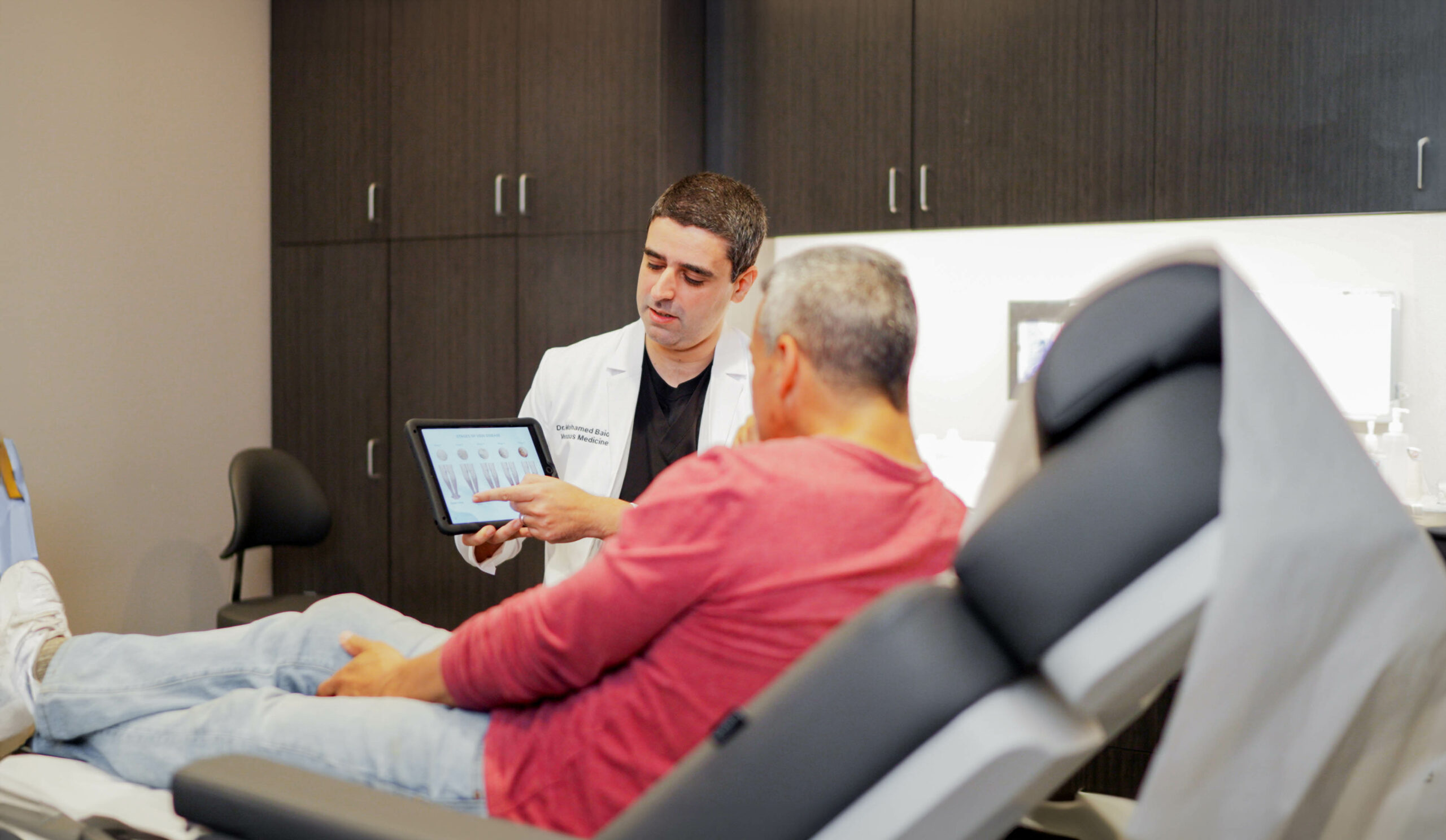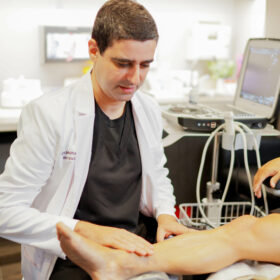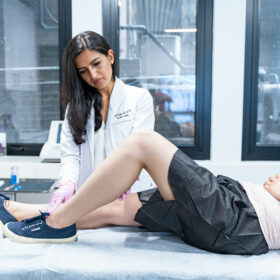Advances in medical technology have paved the way for safer, more effective treatment options for vein issues. At Vein Treatment Clinic, we understand the concerns individuals face when seeking solutions for venous conditions. We’re committed to providing comprehensive care that prioritizes both efficacy and patient comfort. We only offer the safest minimally invasive vein treatments for spider veins and varicose veins, including sclerotherapy, endovenous laser ablation, and VenaSeal. In this article, we explore the benefits of minimally invasive vein treatments compared to traditional vascular surgery.
1. Reduced Risk and Complications
One of the most significant advantages of minimally invasive vein treatment is the reduced risk of complications compared to vascular surgery. Traditional surgical procedures often involve significant incisions, which can lead to higher rates of infection, bleeding, and other post-operative issues. In contrast, minimally invasive techniques utilize small incisions or even no incisions at all, significantly lowering the risk of complications. This means a smoother recovery process and fewer concerns about potential adverse effects.
2. Minimal Scarring
Minimally invasive vein treatments involve minimal scarring. Unlike vascular surgery, which may leave large scars due to extensive incisions, minimally invasive techniques typically result in tiny scars that are barely noticeable. This is particularly advantageous for patients who are concerned about the cosmetic aspect of their treatment. With minimally invasive procedures, you can achieve excellent results without the worry of conspicuous scars.
3. Faster Recovery Time
The downtime associated with surgery is a significant consideration. Minimally invasive vein treatments offer a much faster recovery time compared to traditional vascular surgery. Because these procedures are less invasive, patients typically experience minimal discomfort and can resume their normal activities sooner. In fact, some minimally invasive treatments allow patients to return to work or other daily activities on the same day as their procedure. This means less disruption to your routine and a quicker return to feeling your best.
4. Lower Risk of Nerve Damage
Nerve damage is a potential complication of any surgical procedure, including vascular surgery. However, minimally invasive vein treatments pose a lower risk of nerve damage due to their targeted approach. By utilizing advanced imaging technology, vein specialists can precisely target the affected veins while minimizing the impact on surrounding tissues and nerves. This reduces the likelihood of nerve damage and associated complications.
5. Customized Treatment Plans
At Vein Treatment Clinic, we recognize that every patient is unique, and their vein concerns require personalized attention. Minimally invasive vein treatments offer the flexibility to tailor treatment plans to each individual’s specific needs. Whether you’re dealing with varicose veins, spider veins, or another venous condition, our board-certified vein doctors can develop a customized approach that addresses your concerns effectively.
6. Improved Cosmetic Results
Beyond addressing medical concerns, minimally invasive vein treatments can also deliver superior cosmetic results. These procedures are designed to target and eliminate unsightly veins, resulting in smoother, more attractive skin. Whether you’re seeking treatment for varicose veins or spider veins, you can achieve a more aesthetically pleasing appearance without the need for extensive surgery or prolonged recovery.
7. Long-Term Effectiveness
Perhaps most importantly, minimally invasive vein treatments offer long-term effectiveness in managing venous conditions. These procedures target the underlying cause of vein issues, such as chronic venous insufficiency, rather than merely addressing surface symptoms. By treating the root cause, minimally invasive techniques can provide lasting relief from discomfort and reduce the risk of vein recurrence. This means fewer follow-up appointments and a higher likelihood of sustained improvement in your vein health over time.
Your Minimally Invasive Vein Treatment Options
Minimally invasive vein treatments offer a range of options designed to effectively target and eliminate problematic veins. At Vein Treatment Clinic, we prioritize patient comfort, which is why we offer a variety of minimally invasive techniques tailored to your specific needs. Below, we’ll explore some of the most commonly used treatments and how they improve vein health.
Endovenous Laser Ablation
Endovenous laser ablation, also known as EVLA or endovenous laser therapy, is a minimally invasive procedure used to treat varicose veins and underlying venous insufficiency. During the procedure, a thin laser fiber is inserted into the affected vein under ultrasound guidance. Once in position, the laser emits energy that heats and seals the vein shut, redirecting blood flow to healthier veins. Over time, the treated vein is absorbed by the body, resulting in improved circulation and reduced symptoms.
Radiofrequency Ablation
Similar to endovenous laser ablation, radiofrequency ablation (RFA) is a minimally invasive technique used to treat venous insufficiency and varicose veins. In this procedure, a specialized catheter is inserted into the diseased vein, delivering radiofrequency energy to heat and contract the vein wall. This causes the vein to collapse and eventually be reabsorbed by the body. Radiofrequency ablation offers excellent results with minimal discomfort and downtime, making it a popular choice for vein treatment.
VenaSeal
VenaSeal is a revolutionary vein treatment that utilizes a medical adhesive to seal off diseased veins. During the procedure, a small catheter is inserted into the affected vein, and the VenaSeal adhesive is injected directly into the vein. The adhesive seals the vein shut, preventing blood from flowing through it. Over time, the treated vein is absorbed by the body, and blood is rerouted to healthier veins. VenaSeal is unique in that it does not require tumescent anesthesia or heat energy, offering a virtually painless treatment experience.
ClariVein
ClariVein is a minimally invasive procedure that combines mechanical agitation and chemical sclerosant to treat varicose veins. During the procedure, a small catheter with a rotating tip is inserted into the vein, where it delivers a sclerosing agent while simultaneously agitating the vein wall. This combination of mechanical and chemical action causes the vein to collapse and eventually be absorbed by the body. ClariVein offers precise treatment with minimal discomfort and downtime, making it an excellent option for patients seeking relief from varicose veins.
Ambulatory Phlebectomy
Ambulatory phlebectomy is a minimally invasive surgical technique used to remove large varicose veins through tiny incisions in the skin. Unlike traditional vein-stripping, ambulatory phlebectomy requires only local anesthesia and leaves minimal scarring. During the procedure, the vein is accessed through small punctures, and segments of the vein are removed using specialized instruments. Ambulatory phlebectomy provides immediate relief from symptoms and improves the appearance of the legs, allowing patients to enjoy a faster recovery and return to normal activities sooner.
Sclerotherapy
Sclerotherapy is a minimally invasive treatment for spider veins and smaller varicose veins that involves injecting a sclerosing agent directly into the affected veins. The sclerosing agent irritates the vein walls, causing them to collapse and eventually be reabsorbed by the body. Sclerotherapy is a highly effective treatment option for superficial veins, and multiple sessions may be required to achieve optimal results. This procedure is virtually painless and requires no downtime, allowing patients to resume their daily activities immediately after treatment.
Minimally Invasive Vein Treatment FAQs
1. Is minimally invasive vein treatment painful?
Minimally invasive vein treatments involve minimal discomfort and provide a more comfortable experience compared to traditional surgical procedures. Most patients report only mild discomfort during the procedure, which is typically well-tolerated with local anesthesia or mild sedation. After the procedure, some patients may experience temporary soreness or bruising, but this can usually be managed with over-the-counter pain medication.
2. How long does it take to recover from minimally invasive vein treatment?
Recovery times vary depending on the specific treatment and individual factors, but most patients can resume normal activities within a few days to a week after minimally invasive vein treatment. Some procedures, such as sclerotherapy, may require little to no downtime, while others, like ambulatory phlebectomy, may involve a slightly longer recovery period. Your vein specialist will provide post-procedure instructions to help facilitate a smooth recovery.
3. Are minimally invasive vein treatments covered by insurance?
In many cases, minimally invasive vein treatments are considered medically necessary and may be covered by insurance. However, coverage policies vary depending on your insurance provider and individual circumstances. Our team at Vein Treatment Clinic can assist you in verifying your insurance coverage and exploring your options for payment or financing.
4. How long do the results of minimally invasive vein treatment last?
Minimally invasive vein treatments provide long-lasting results by addressing the underlying cause of venous conditions. While individual experiences may vary, many patients experience significant improvement in vein symptoms and appearance that can last for years after treatment. To optimize and maintain your results, it’s important to follow your vein specialist’s recommendations for post-procedure care and lifestyle modifications.
5. Are there any risks or complications associated with minimally invasive vein treatment?
Like any medical procedure, minimally invasive vein treatments carry a small risk of complications. However, these risks are significantly lower compared to traditional surgical techniques. Common side effects may include minor bruising, swelling, or discomfort, which typically resolve on their own within a few days. Serious complications are rare but may include allergic reactions, infection, or blood clots. Your vein specialist will discuss potential risks and benefits with you before proceeding with treatment.
Schedule Your Minimally Invasive Vein Treatment
The benefits of minimally invasive vein treatment over vascular surgery are undeniable. From reduced risk and faster recovery to improved cosmetic results and long-term effectiveness, these procedures offer a comprehensive solution for venous conditions with minimal disruption to your life. If you’re ready to experience the advantages of minimally invasive vein treatment, we invite you to schedule a consultation with us at Vein Treatment Clinic — you can find our board-certified vein doctors in New York, New Jersey, Maryland, and California.












